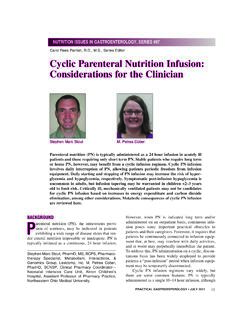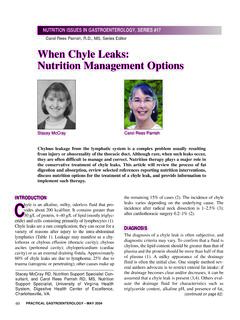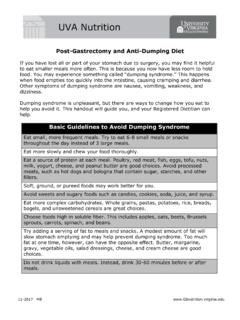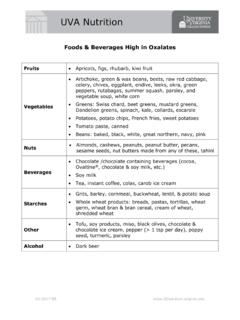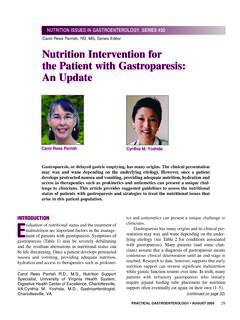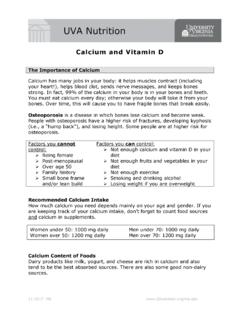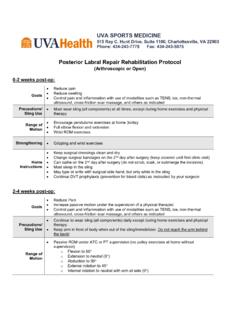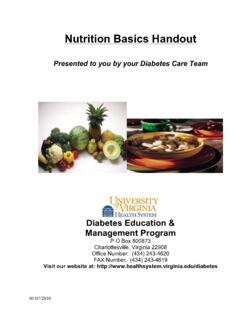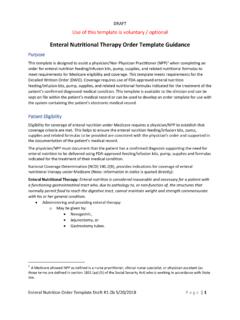Transcription of NUTRITION ISSUES IN GASTROENTEROLOGY, SERIES #185
1 Carol Rees Parrish, MS, RDN, SERIES Editor32 PRACTICAL GASTROENTEROLOGY APRIL 2019 NUTRITION ISSUES IN GASTROENTEROLOGY, SERIES #185 Part III Jejunal enteral Feeding: The Tail is Wagging the Dog(ma)Dispelling Myths with Physiology, Evidence, and Clinical ExperienceMeagan Bridges, RD, NUTRITION Support Specialist Carol Rees Parrish, MS, RDN, NUTRITION Support Specialist, University of Virginia Health System, Digestive Health Center, Charlottesville, VAJejunal feeding is the next best option for patients who cannot tolerate gastric feedings and would otherwise be placed on parenteral NUTRITION . Yet, it remains beleaguered by dogmatic rules with very little substantiating evidence or conformity with physiology. Part III of this enteral SERIES serves to dispel some of the long-standing myths that are still widely practiced today and result in unsuccessful jejunal Published or Upcoming in this SERIES : Part I enteral Feeding Barriers: Pesky Bowel Sounds & Gastric Residual Volumes Part II enteral Feeding: Eradicate Barriers with Root Cause Analysis and Focused Intervention Part IV enteral Feeding: Hydrating the Enterally-Fed Patient It Isn t Rocket ScienceCarol Rees ParrishMeagan BridgesAt the same time, certain rules regarding JF have arisen and taken on the force of dogma without rigorous evidence or regard for our understanding of gastrointestinal physiology.
2 Examples of such dogma include: 1. Only elemental EN can be used2. Only isotonic formulas can be used3. JF causes diarrheaINTRODUCTIONS ince the first documented feeding via jejunostomy in the late 19th century, jejunal feedings (JF) have become a viable and common route for enteral NUTRITION (EN) in many patients for reasons ranging from GI obstructions, to necrotizing pancreatitis, to high aspiration risk. (continued on page 38)38 PRACTICAL GASTROENTEROLOGY APRIL 2019 NUTRITION ISSUES IN GASTROENTEROLOGY, SERIES ##185 Part III Jejunal enteral Feeding: The Tail is Wagging the Dog(ma)(continued from page 32)into question whether the J-tube is appropriately positioned, and an abdominal film may be necessary to determine location. If clogging of jejunal tubes or j-arms is a frequent problem in your facility, consider the size of the J-tube in use; the larger the French size, the less likely it will next several sections address the most widespread myths about JF and present alternatives based on physiology, evidence, and clinical experience.
3 Myth #1: Only Elemental Formulas Can be UsedConsider the physiology first. Pancreatic enzymes are needed to break down proteins, large polysaccharides, and fat. Bile salts are also needed for fat absorption. Any functioning pancreas and biliary system will produce pancreaticobiliary secretions that will reach the jejunum (as long as there is no external drain or luminal obstruction below the site where these important secretions 4. JF cannot infuse over 80-100mL/hr or via bolus or gravity drip5. Residuals from a J-tube should be routinely checked 6. Water flushes over 100mL cause necrotic bowelThese types of rules often prevent our JF patients from receiving optimal, or even adequate, NUTRITION . The purpose of this article is to review the literature, gastrointestinal physiology, and clinical experience that lead us to question many of these long-standing conventions and dispel the mysticism surrounding JF.)
4 Indications for Jejunal Feeding and Types of J-Tubes"In some circumstances, the evidence for jejunal over gastric feeding is questionable, but the reality is that there are times when JF is needed simply because gastric feeding is just not working (Table 1). As Table 2 notes, each type of J-tube carries its own set of specifications. Bear in mind that any tube that originates in the jejunum or is threaded through the stomach into the jejunum can migrate into the stomach, leading to complications."At our institution, if long term access is required, we often use percutaneous endoscopic gastrostomy-jejunostomy (PEG-J) tubes where the PEG is strategically placed in the lower antrum facing the pylorus. This reduces the length of the J-arm traversing through the stomach, thereby minimizing the risk for coiling and migration back into the stomach.
5 We also use 24-Fr PEGs to accommodate a 12-Fr J-arm (largest J-arm on the market). PEGs < 24-Fr can only accommodate J-arms < 10-Fr, which clog much more easily. In addition, we use nasojejunal or orojejunal tubes in ICU patients who need to be fed post-pylorically over the short-term, but these frequently coil and/or migrate back into the stomach. NG-Js are theoretically a good approach, but we have not had much success with these at our institution as they are prone to clogging and are uncomfortable for the sudden onset of GI symptoms in a patient who has demonstrated tolerance of JF should call Table 1. Indications for Jejunal Feeding Severe gastroparesis (not just history of) Proximal enterocutaneous fistula and jejunal access possible below Severe acute pancreatitis Chronic pancreatitis (if oral intake causes ongoing abdominal pain and malnutrition) Gastric or proximal small bowel obstruction Recurrent aspirations from below the stomach (not oropharyngeal secretions or food, or a patient who fails a modified barium swallow) Incompetent gastroesophageal junction ( scleroderma) Esophageal dysmotility Significant gastric compression for any reason tumor, enlarged kidneys, etc.
6 Intolerance of gastric feeding (see Table 6) NUTRITION ISSUES IN GASTROENTEROLOGY, SERIES #185 PRACTICAL GASTROENTEROLOGY APRIL 2019 39 Part III Jejunal enteral Feeding: The Tail is Wagging the Dog(ma)nitrogen, and fat in intraduodenal Even in patients with total pancreatectomies, it has been shown that 60% of intact protein can still be assimilated, owing to the role of the small intestine itself in protein #2: Only Isotonic Formulas Can be UsedPhysiologically, whatever we eat or drink is automatically diluted. Indeed, food or EN constitutes only a small fraction of the total contents of the gastrointestinal (GI) tract. As Table 3 shows, between saliva, gastric secretions, pancreaticobiliary secretions, and succus entericus, the average person s GI tract secretes and reabsorbs around 7 L of gastrointestinal fluid (including 3-5 L originating above the pylorus alone).
7 These 7 L of gastrointestinal fluid will significantly dilute whatever we consume or infuse, which is usually around 2 L/day. Even substances that are considered very enter), allowing for the use of polymeric formulas, regardless of whether a patient is fed gastrically or jejunally. Even in the fasting state, the pancreas secretes enzymes at around 20% of maximal output, and bile secretions amount to roughly 620mL/day, which will enter the jejunum and help digest polymeric efficiency at digesting and absorbing nutrients is supported in the literature. Hecketsweiler, et al., for example, compared elemental vs. polymeric absorption rates in JF by infusing either a kcal/mL elemental solution (amino acids, glucose and glucose oligosaccharides), or a kcal/mL polymeric mixture (chicken meat, egg-yolk power, soya flour, glucose, saccharose, maltose and dextrin maltose, corn and wheat oils), in 25 healthy subjects and showed that polymeric EN is absorbed within the first 105cm of the small Similarly, Raimundo, et al.
8 Demonstrated near complete assimilation of carbohydrates, Table 2. Types of Jejunal Feeding TubesTypeCommentsNasojejunal / Orojejunal Commonly used in ICUs Clogs easily, especially if using < 12-FrNG-J Salem sump type tube with jejunal extensiono Uncomfortable for patients over the long-term J-tube extension is < 10-Fr, leading to frequent clogsPEG-J / Jet-PEG Place PEG in lower antrum to the right of spine Use 24-Fr PEG to accommodate 12-Fr J-armo If G- or J-tube clogs, only replace the clogged portion, not the entire thingG-J Single Tube J-arms are < 10-Fr, leading to frequent clogging Since it is a single tube, if either the J-portion or the G-portion clogs, the entire tube must be replacedDirect PEJ More difficult to place in endoscopy Used in those with partial/total gastric resections (jejunum is higher up)
9 Surgical J Requires OR CostlyFistuloclysis17 Tube placed through fistula into jejunum Need to determine if patient has enough small bowel surface area below vs. above fistula to absorb adequately Not for short-term use or for patients whose fistula is trying to close 40 PRACTICAL GASTROENTEROLOGY APRIL 2019 NUTRITION ISSUES IN GASTROENTEROLOGY, SERIES ##185 Part III Jejunal enteral Feeding: The Tail is Wagging the Dog(ma) NUTRITION ISSUES IN GASTROENTEROLOGY, SERIES #185= 1mL/minute [1/5th of a teaspoon]; 120mL/hour = 2mL/minute [< teaspoon]), and as soon as it leaves the ports of the feeding tube, it is mixed immediately with gastric or intestinal secretions and diluted--this inconsistency in practice is difficult to #3: Jejunal Feeding Causes DiarrheaThis particular myth has been applied to both jejunal and gastric feedings alike, when in reality, diarrhea is a common complaint among hospitalized patients, regardless of whether they are receiving EN.
10 Because of the many factors associated with diarrhea in the hospital setting, the challenge for the clinician is that EN-associated diarrhea is a diagnosis of exclusion rather than the most likely cause. It is imperative to review the medication list for diarrheagens. Some medications, such as antibiotics, cannot be modified. Others, however, can be changed or eliminated, especially liquid preparations, which often contain sugar alcohols (sorbitol in particular) that are highly fermentable and diarrheagenic (Table 4). By de-emphasizing extraneous substances entering the gut, it will be easier to identify the root cause of the diarrhea. If medications cannot be entirely eliminated, try switching from liquid to tablet crush and flush or capsule preparations if available.
